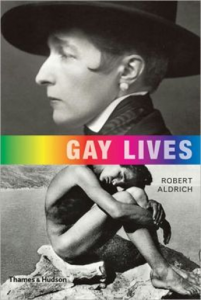 Robert Aldrich. Gay Lives. Thames & Hudson, 2012. Hardcover. 304p. $29.95. ISBN 978-0-500-25190-4. [128 illustrations; 56 in color]
Robert Aldrich. Gay Lives. Thames & Hudson, 2012. Hardcover. 304p. $29.95. ISBN 978-0-500-25190-4. [128 illustrations; 56 in color]
These 67 biographical sketches of deceased individuals and seven of couples oriented toward same-sex relationships stretch from 2400 B.C.E. to the recent past from all over the world.
Aldrich, a professor of European History at the University of Sydney (Australia) writes in a clear, straight-forward style. The pairs focus on those who are eternally linked in history, such David and Jonathan; the individual sketches often describe multiple relationships.
Lavishly illustrated with portraits, paintings, photographs and other illustrations, the book is printed on heavy paper, giving the illusion that the illustrations are plates.
Ranging from two to four pages, the sketches each have sources listed at the back of the volume next to a comprehensive name index leading to the individuals mentioned in the sketches. Several other persons are included in most of the sketches, and cultural and historical background enhance the information.
The mystery is the reason behind Aldrich’s decision of people to highlight. Many are famous (Sappho, Michelangelo, Walt Whitman, Christopher Isherwood, Oscar Wilde, T.E. Lawrence, Del Martin, Harvey Milk), but others are not. Most subjects lived in Europe, but Egypt, Israel, China, the USA, Australia, Brazil, Japan, South Africa, Sri Lanka, Vietnam, India, and Iran are also represented.
Although occupations are extremely varied, the subjects are primarily poets, writers, photographers, painters, and other artists. Several are soldiers, emperors, or kings. Less common are a philosopher, religious (a monk, a friar, a nun, a cardinal), sexologists, a politician, a diplomat, teachers, a sinologist, and even a criminal and a waiter. Most of the subjects are men; only 17 sketches of women are included.
Arranged somewhat chronologically, the sketches begin with “Ancient Ancestors,†followed by the Middle Ages and the Enlightenment, “Founding Fathers and Mothers†mostly from the 19th and early 20th centuries, “The Fin-de-siècle and Belle Époque,†and ending with the recent past. Other sections are more topical: “Women Who Loved Women,†sex and politics, male beauty, “Radicals and Activists.â€Â Some sections are geographical: “Love in the Levant,†“Japonisme,†and “International Lives in the Modern Era.â€
Every library with any interest in the lives of LGBT folk will want to add this beautiful book to their collection.
Reviewer: James Doig Anderson, Professor Emeritus Library and Information Science, Rutgers University
